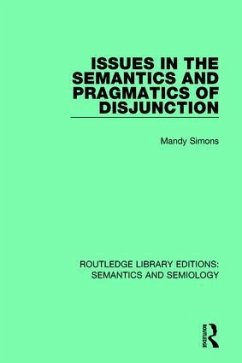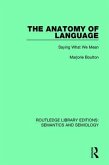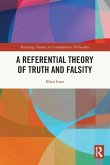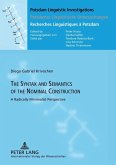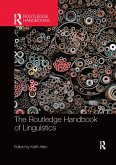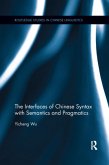Mandy Simons
Issues in the Semantics and Pragmatics of Disjunction
Mandy Simons
Issues in the Semantics and Pragmatics of Disjunction
- Broschiertes Buch
- Merkliste
- Auf die Merkliste
- Bewerten Bewerten
- Teilen
- Produkt teilen
- Produkterinnerung
- Produkterinnerung
First published in 2000, this book is about sentences containing the word or, dealing primarily with sentences in which or conjoins clauses, but also some cases in which it conjoins expressions of other categories. The author aims to give an account of the discourse properties and felicity conditions of disjunction, and to use this account in explaining the behaviour of presupposition projection and of anaphora in disjunctive sentences. The author begins by giving an account of the discourse properties and felicity conditions of disjunction before turning to the presupposition projection…mehr
Andere Kunden interessierten sich auch für
![The Anatomy of Language The Anatomy of Language]() Marjorie BoultonThe Anatomy of Language54,99 €
Marjorie BoultonThe Anatomy of Language54,99 €![Meaning Meaning]() Betty J. Birner (USA Northern Illinois University)Meaning49,99 €
Betty J. Birner (USA Northern Illinois University)Meaning49,99 €![A Referential Theory of Truth and Falsity A Referential Theory of Truth and Falsity]() Ilhan InanA Referential Theory of Truth and Falsity42,99 €
Ilhan InanA Referential Theory of Truth and Falsity42,99 €![Introducing English Language Introducing English Language]() Louise Mullany (UK University of Nottingham)Introducing English Language39,99 €
Louise Mullany (UK University of Nottingham)Introducing English Language39,99 €![The Syntax and Semantics of the Nominal Construction The Syntax and Semantics of the Nominal Construction]() Diego Gabriel KrivochenThe Syntax and Semantics of the Nominal Construction43,60 €
Diego Gabriel KrivochenThe Syntax and Semantics of the Nominal Construction43,60 €![The Routledge Handbook of Linguistics The Routledge Handbook of Linguistics]() The Routledge Handbook of Linguistics51,99 €
The Routledge Handbook of Linguistics51,99 €![The Interfaces of Chinese Syntax with Semantics and Pragmatics The Interfaces of Chinese Syntax with Semantics and Pragmatics]() Yicheng WuThe Interfaces of Chinese Syntax with Semantics and Pragmatics46,99 €
Yicheng WuThe Interfaces of Chinese Syntax with Semantics and Pragmatics46,99 €-
-
-
First published in 2000, this book is about sentences containing the word or, dealing primarily with sentences in which or conjoins clauses, but also some cases in which it conjoins expressions of other categories. The author aims to give an account of the discourse properties and felicity conditions of disjunction, and to use this account in explaining the behaviour of presupposition projection and of anaphora in disjunctive sentences. The author begins by giving an account of the discourse properties and felicity conditions of disjunction before turning to the presupposition projection problem. The final two chapters discuss anaphora and its interactions with disjunction.
Produktdetails
- Produktdetails
- Routledge Library Editions: Semantics and Semiology
- Verlag: Taylor & Francis Ltd
- Seitenzahl: 276
- Erscheinungstermin: 27. Februar 2018
- Englisch
- Abmessung: 234mm x 156mm x 15mm
- Gewicht: 426g
- ISBN-13: 9781138697959
- ISBN-10: 1138697958
- Artikelnr.: 52643534
- Herstellerkennzeichnung
- Libri GmbH
- Europaallee 1
- 36244 Bad Hersfeld
- gpsr@libri.de
- Routledge Library Editions: Semantics and Semiology
- Verlag: Taylor & Francis Ltd
- Seitenzahl: 276
- Erscheinungstermin: 27. Februar 2018
- Englisch
- Abmessung: 234mm x 156mm x 15mm
- Gewicht: 426g
- ISBN-13: 9781138697959
- ISBN-10: 1138697958
- Artikelnr.: 52643534
- Herstellerkennzeichnung
- Libri GmbH
- Europaallee 1
- 36244 Bad Hersfeld
- gpsr@libri.de
Simons, Mandy
1. Introduction; 1.1. Overview 1.1.1. What this dissertation is about
1.1.2. Context change: Pragmatic vs. semantic approaches 1.2. The
Stalnakerian Model of Presupposition and Assertion 1.3. Dynamic Semantics
1.3.1. The Fundamentals 1.3.2. File Change Semantics (FCS) and the CCP
proposal 1.3.3. Discourse Representation Theory (DRT) 1.3.4. Dynamic
Montague Grammar (DMG) Notes to Chapter One; 2. Disjunctive Sentences In
Discourse; 2.1. Introduction 2.2. The Discourse Function and Felicity
Conditions of Disjunction 2.2.1. The Basic Observations 2.2.2. Relation and
Manner in the Stalnakerian Model 2.3. The Enriched Context Change Framework
2.3.1. Presentation 2.3.2. Disjunction and the Relevant Informativity
Condition 2.3.3. Disjunction and Simplicity 2.3.4. Disjunction and Rooth's
Alternative Semantics 2.3.5. Summary 2.4. Some Exceptions 2.4.1. Floutings
2.4.2. Reasoning contexts 2.4.3. Metalinguistic or 2.5. The Exclusive
Interpretation of or 2.5.1. Critique of the ambiguity account 2.5.2.
Gazdar's (1979) account 2.5.3. Exclusivity from exhaustiveness 2.5.4.
Exclusivity from alternativeness 2.5.5. Summary 2.6. Conclusion Notes to
Chapter Two; 3. Presupposition Projection; 3.1. Introduction 3.1.1. The
Basic Question 3.1.2. The Theoretical Issues 3.2. The Data 3.3. The
Satisfaction Account of Presupposition Projection 3.3.1. Basics of the
Satisfaction Account 3.3.2. CCPs for disjunction 3.3.3. Critique 3.4.
Towards a New Account 3.4.1. Gazdar's cancellation theory 3.4.2. The
accommodation view: Van der Sandt (1992) 3.4.3. Translating DRSs into
Stalnakerian contexts 3.5. The Account in Action 3.5.1. Basic cases 3.5.2.
Entailing disjunctions again 3.5.3. Beaver's counterexample 3.6. Conclusion
Notes to Chapter Three; 4. Internal Anaphora; 4.1. Introduction 4.2.
Anaphora-based Accounts in Dynamic Semantic Theories 4.2.1. DMG:
Groenendijk and Stokhof (1990) 4.2.2. DRT: Kamp and Reyle (1993) 4.2.3. A
second DRT proposal: Krahmer and Muskens (1994) 4.2.4. Van der Sandt (1992)
revisited 4.3. A Felicity-based Approach 4.3.1. Introduction to the account
4.3.2. The E-type account of anaphora 4.3.3. A felicity-based solution to
the internal anaphora puzzle 4.3.4. Summary 4.4. Further Data 4.4.1. Narrow
scope antecedents 4.4.2. Non-E-type unbound anaphora 4.4.3. Pleonastic
pronouns 4.5. Conclusion Notes to Chapter Four; 5. External Anaphora; 5.1.
Introduction 5.2. The Basic Data 5.2.1. Anaphora to a disjunction of NPs
5.2.2. Clausal disjunction 5.3. A First Reformulation of the E-type Account
5.4. A Compositional Structural E-type Account 5.4.1. Presentation 5.4.2.
Comparison with Chapter Four account 5.4.3. Narrow scope antecedents 5.5.
Application to the External Anaphora Data 5.5.1. Anaphora to a disjunction
of NPs 5.5.2. Anaphora to clausal disjunctions 5.5.3. Summary 5.6. The
Single-antecedent Reading 5.6.1. Derivation of single-antecedent readings
5.6.2. Maximal quantifier antecedents 5.6.3. Summary 5.7. Other Approaches
to External Anaphora 5.8. Further Issues for the E-type Account 5.8.1.
Inference-based anaphora 5.8.2. Interpretation of plural pronouns 5.8.3.
Anaphora to NP disjuncts and conjuncts 5.9. Conclusion Notes to Chapter
Five; Concluding Remarks; Grice, Stalnaker and Dynamic Semantics; Appendix;
Bibliography; Index
1.1.2. Context change: Pragmatic vs. semantic approaches 1.2. The
Stalnakerian Model of Presupposition and Assertion 1.3. Dynamic Semantics
1.3.1. The Fundamentals 1.3.2. File Change Semantics (FCS) and the CCP
proposal 1.3.3. Discourse Representation Theory (DRT) 1.3.4. Dynamic
Montague Grammar (DMG) Notes to Chapter One; 2. Disjunctive Sentences In
Discourse; 2.1. Introduction 2.2. The Discourse Function and Felicity
Conditions of Disjunction 2.2.1. The Basic Observations 2.2.2. Relation and
Manner in the Stalnakerian Model 2.3. The Enriched Context Change Framework
2.3.1. Presentation 2.3.2. Disjunction and the Relevant Informativity
Condition 2.3.3. Disjunction and Simplicity 2.3.4. Disjunction and Rooth's
Alternative Semantics 2.3.5. Summary 2.4. Some Exceptions 2.4.1. Floutings
2.4.2. Reasoning contexts 2.4.3. Metalinguistic or 2.5. The Exclusive
Interpretation of or 2.5.1. Critique of the ambiguity account 2.5.2.
Gazdar's (1979) account 2.5.3. Exclusivity from exhaustiveness 2.5.4.
Exclusivity from alternativeness 2.5.5. Summary 2.6. Conclusion Notes to
Chapter Two; 3. Presupposition Projection; 3.1. Introduction 3.1.1. The
Basic Question 3.1.2. The Theoretical Issues 3.2. The Data 3.3. The
Satisfaction Account of Presupposition Projection 3.3.1. Basics of the
Satisfaction Account 3.3.2. CCPs for disjunction 3.3.3. Critique 3.4.
Towards a New Account 3.4.1. Gazdar's cancellation theory 3.4.2. The
accommodation view: Van der Sandt (1992) 3.4.3. Translating DRSs into
Stalnakerian contexts 3.5. The Account in Action 3.5.1. Basic cases 3.5.2.
Entailing disjunctions again 3.5.3. Beaver's counterexample 3.6. Conclusion
Notes to Chapter Three; 4. Internal Anaphora; 4.1. Introduction 4.2.
Anaphora-based Accounts in Dynamic Semantic Theories 4.2.1. DMG:
Groenendijk and Stokhof (1990) 4.2.2. DRT: Kamp and Reyle (1993) 4.2.3. A
second DRT proposal: Krahmer and Muskens (1994) 4.2.4. Van der Sandt (1992)
revisited 4.3. A Felicity-based Approach 4.3.1. Introduction to the account
4.3.2. The E-type account of anaphora 4.3.3. A felicity-based solution to
the internal anaphora puzzle 4.3.4. Summary 4.4. Further Data 4.4.1. Narrow
scope antecedents 4.4.2. Non-E-type unbound anaphora 4.4.3. Pleonastic
pronouns 4.5. Conclusion Notes to Chapter Four; 5. External Anaphora; 5.1.
Introduction 5.2. The Basic Data 5.2.1. Anaphora to a disjunction of NPs
5.2.2. Clausal disjunction 5.3. A First Reformulation of the E-type Account
5.4. A Compositional Structural E-type Account 5.4.1. Presentation 5.4.2.
Comparison with Chapter Four account 5.4.3. Narrow scope antecedents 5.5.
Application to the External Anaphora Data 5.5.1. Anaphora to a disjunction
of NPs 5.5.2. Anaphora to clausal disjunctions 5.5.3. Summary 5.6. The
Single-antecedent Reading 5.6.1. Derivation of single-antecedent readings
5.6.2. Maximal quantifier antecedents 5.6.3. Summary 5.7. Other Approaches
to External Anaphora 5.8. Further Issues for the E-type Account 5.8.1.
Inference-based anaphora 5.8.2. Interpretation of plural pronouns 5.8.3.
Anaphora to NP disjuncts and conjuncts 5.9. Conclusion Notes to Chapter
Five; Concluding Remarks; Grice, Stalnaker and Dynamic Semantics; Appendix;
Bibliography; Index
1. Introduction; 1.1. Overview 1.1.1. What this dissertation is about
1.1.2. Context change: Pragmatic vs. semantic approaches 1.2. The
Stalnakerian Model of Presupposition and Assertion 1.3. Dynamic Semantics
1.3.1. The Fundamentals 1.3.2. File Change Semantics (FCS) and the CCP
proposal 1.3.3. Discourse Representation Theory (DRT) 1.3.4. Dynamic
Montague Grammar (DMG) Notes to Chapter One; 2. Disjunctive Sentences In
Discourse; 2.1. Introduction 2.2. The Discourse Function and Felicity
Conditions of Disjunction 2.2.1. The Basic Observations 2.2.2. Relation and
Manner in the Stalnakerian Model 2.3. The Enriched Context Change Framework
2.3.1. Presentation 2.3.2. Disjunction and the Relevant Informativity
Condition 2.3.3. Disjunction and Simplicity 2.3.4. Disjunction and Rooth's
Alternative Semantics 2.3.5. Summary 2.4. Some Exceptions 2.4.1. Floutings
2.4.2. Reasoning contexts 2.4.3. Metalinguistic or 2.5. The Exclusive
Interpretation of or 2.5.1. Critique of the ambiguity account 2.5.2.
Gazdar's (1979) account 2.5.3. Exclusivity from exhaustiveness 2.5.4.
Exclusivity from alternativeness 2.5.5. Summary 2.6. Conclusion Notes to
Chapter Two; 3. Presupposition Projection; 3.1. Introduction 3.1.1. The
Basic Question 3.1.2. The Theoretical Issues 3.2. The Data 3.3. The
Satisfaction Account of Presupposition Projection 3.3.1. Basics of the
Satisfaction Account 3.3.2. CCPs for disjunction 3.3.3. Critique 3.4.
Towards a New Account 3.4.1. Gazdar's cancellation theory 3.4.2. The
accommodation view: Van der Sandt (1992) 3.4.3. Translating DRSs into
Stalnakerian contexts 3.5. The Account in Action 3.5.1. Basic cases 3.5.2.
Entailing disjunctions again 3.5.3. Beaver's counterexample 3.6. Conclusion
Notes to Chapter Three; 4. Internal Anaphora; 4.1. Introduction 4.2.
Anaphora-based Accounts in Dynamic Semantic Theories 4.2.1. DMG:
Groenendijk and Stokhof (1990) 4.2.2. DRT: Kamp and Reyle (1993) 4.2.3. A
second DRT proposal: Krahmer and Muskens (1994) 4.2.4. Van der Sandt (1992)
revisited 4.3. A Felicity-based Approach 4.3.1. Introduction to the account
4.3.2. The E-type account of anaphora 4.3.3. A felicity-based solution to
the internal anaphora puzzle 4.3.4. Summary 4.4. Further Data 4.4.1. Narrow
scope antecedents 4.4.2. Non-E-type unbound anaphora 4.4.3. Pleonastic
pronouns 4.5. Conclusion Notes to Chapter Four; 5. External Anaphora; 5.1.
Introduction 5.2. The Basic Data 5.2.1. Anaphora to a disjunction of NPs
5.2.2. Clausal disjunction 5.3. A First Reformulation of the E-type Account
5.4. A Compositional Structural E-type Account 5.4.1. Presentation 5.4.2.
Comparison with Chapter Four account 5.4.3. Narrow scope antecedents 5.5.
Application to the External Anaphora Data 5.5.1. Anaphora to a disjunction
of NPs 5.5.2. Anaphora to clausal disjunctions 5.5.3. Summary 5.6. The
Single-antecedent Reading 5.6.1. Derivation of single-antecedent readings
5.6.2. Maximal quantifier antecedents 5.6.3. Summary 5.7. Other Approaches
to External Anaphora 5.8. Further Issues for the E-type Account 5.8.1.
Inference-based anaphora 5.8.2. Interpretation of plural pronouns 5.8.3.
Anaphora to NP disjuncts and conjuncts 5.9. Conclusion Notes to Chapter
Five; Concluding Remarks; Grice, Stalnaker and Dynamic Semantics; Appendix;
Bibliography; Index
1.1.2. Context change: Pragmatic vs. semantic approaches 1.2. The
Stalnakerian Model of Presupposition and Assertion 1.3. Dynamic Semantics
1.3.1. The Fundamentals 1.3.2. File Change Semantics (FCS) and the CCP
proposal 1.3.3. Discourse Representation Theory (DRT) 1.3.4. Dynamic
Montague Grammar (DMG) Notes to Chapter One; 2. Disjunctive Sentences In
Discourse; 2.1. Introduction 2.2. The Discourse Function and Felicity
Conditions of Disjunction 2.2.1. The Basic Observations 2.2.2. Relation and
Manner in the Stalnakerian Model 2.3. The Enriched Context Change Framework
2.3.1. Presentation 2.3.2. Disjunction and the Relevant Informativity
Condition 2.3.3. Disjunction and Simplicity 2.3.4. Disjunction and Rooth's
Alternative Semantics 2.3.5. Summary 2.4. Some Exceptions 2.4.1. Floutings
2.4.2. Reasoning contexts 2.4.3. Metalinguistic or 2.5. The Exclusive
Interpretation of or 2.5.1. Critique of the ambiguity account 2.5.2.
Gazdar's (1979) account 2.5.3. Exclusivity from exhaustiveness 2.5.4.
Exclusivity from alternativeness 2.5.5. Summary 2.6. Conclusion Notes to
Chapter Two; 3. Presupposition Projection; 3.1. Introduction 3.1.1. The
Basic Question 3.1.2. The Theoretical Issues 3.2. The Data 3.3. The
Satisfaction Account of Presupposition Projection 3.3.1. Basics of the
Satisfaction Account 3.3.2. CCPs for disjunction 3.3.3. Critique 3.4.
Towards a New Account 3.4.1. Gazdar's cancellation theory 3.4.2. The
accommodation view: Van der Sandt (1992) 3.4.3. Translating DRSs into
Stalnakerian contexts 3.5. The Account in Action 3.5.1. Basic cases 3.5.2.
Entailing disjunctions again 3.5.3. Beaver's counterexample 3.6. Conclusion
Notes to Chapter Three; 4. Internal Anaphora; 4.1. Introduction 4.2.
Anaphora-based Accounts in Dynamic Semantic Theories 4.2.1. DMG:
Groenendijk and Stokhof (1990) 4.2.2. DRT: Kamp and Reyle (1993) 4.2.3. A
second DRT proposal: Krahmer and Muskens (1994) 4.2.4. Van der Sandt (1992)
revisited 4.3. A Felicity-based Approach 4.3.1. Introduction to the account
4.3.2. The E-type account of anaphora 4.3.3. A felicity-based solution to
the internal anaphora puzzle 4.3.4. Summary 4.4. Further Data 4.4.1. Narrow
scope antecedents 4.4.2. Non-E-type unbound anaphora 4.4.3. Pleonastic
pronouns 4.5. Conclusion Notes to Chapter Four; 5. External Anaphora; 5.1.
Introduction 5.2. The Basic Data 5.2.1. Anaphora to a disjunction of NPs
5.2.2. Clausal disjunction 5.3. A First Reformulation of the E-type Account
5.4. A Compositional Structural E-type Account 5.4.1. Presentation 5.4.2.
Comparison with Chapter Four account 5.4.3. Narrow scope antecedents 5.5.
Application to the External Anaphora Data 5.5.1. Anaphora to a disjunction
of NPs 5.5.2. Anaphora to clausal disjunctions 5.5.3. Summary 5.6. The
Single-antecedent Reading 5.6.1. Derivation of single-antecedent readings
5.6.2. Maximal quantifier antecedents 5.6.3. Summary 5.7. Other Approaches
to External Anaphora 5.8. Further Issues for the E-type Account 5.8.1.
Inference-based anaphora 5.8.2. Interpretation of plural pronouns 5.8.3.
Anaphora to NP disjuncts and conjuncts 5.9. Conclusion Notes to Chapter
Five; Concluding Remarks; Grice, Stalnaker and Dynamic Semantics; Appendix;
Bibliography; Index

